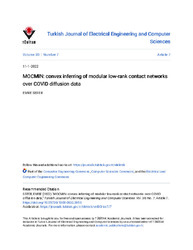MOCMIN: convex inferring of modular low-rank contact networks over COVID diffusion data
| dc.contributor.author | Sefer, Emre | |
| dc.date.accessioned | 2023-08-07T11:39:00Z | |
| dc.date.available | 2023-08-07T11:39:00Z | |
| dc.date.issued | 2022 | |
| dc.identifier.issn | 1300-0632 | en_US |
| dc.identifier.uri | http://hdl.handle.net/10679/8580 | |
| dc.identifier.uri | https://journals.tubitak.gov.tr/elektrik/vol30/iss7/7/ | |
| dc.description.abstract | SEIR (which consists of susceptible, exposed, infected, and recovered states) is a common diffusion model which could model different disease propagation dynamics across various domains such as influenza and COVID diffusion. As a motivation, across these domains, observing the node states is relatively easier than observing the network edges over which the diffusion is taking place, or it may not even be possible to observe the underlying network. This paper focuses on the problem of predicting modular low-rank human contact network edges only if a SEIR diffusion dynamics spreading among the human on their contact network can be observed. Such contact networks exhibit high modularity where the graph has dense connections between the vertices within modules, but sparse connections between vertices in different modules. We first formulate such inference problem as an optimization problem, discuss its convexity, and propose MOCMIN to optimally infer such unknown contacts of modular human contact network from COVID diffusion data. This modular contact network inference problem is important in the general case where human states such as infected with virus and recovered from virus can be identified more easily than the contacts between humans. Our contributions can be summarized as follows: (1) MOCMIN can handle noisy, incomplete, or undersampled diffusion data while inferring the unknown contact network; (2) The inferred contact networks are highly modular which cannot be ensured by the existing methods; (3) This paper applies MOCMIN to better understand COVID diffusion on contact network. We found MOCMIN to be accurate in modular real human contact network inference from COVID diffusion data under a number of challenging scenarios. As an example, such high school contact network can be inferred by tracking COVID diffusion among humans approximately 5% better than the compared methods by MOCMIN’s ability to model modularity of the network. Via such inference, we can also understand the details of COVID diffusion dynamics in real human contact network. Additionally, inferred human contact graphs nearly mimic the true contact network’s known graphical properties. Lastly, MOCMIN outperforms the competing approaches while estimating the synthetic networks. | en_US |
| dc.language.iso | eng | en_US |
| dc.publisher | TÜBİTAK | en_US |
| dc.relation.ispartof | Turkish Journal of Electrical Engineering and Computer Sciences | |
| dc.rights | openAccess | |
| dc.rights.uri | https://creativecommons.org/licenses/by/4.0/ | |
| dc.title | MOCMIN: convex inferring of modular low-rank contact networks over COVID diffusion data | en_US |
| dc.type | Article | en_US |
| dc.description.version | Publisher version | en_US |
| dc.peerreviewed | yes | en_US |
| dc.publicationstatus | Published | en_US |
| dc.contributor.department | Özyeğin University | |
| dc.contributor.authorID | (ORCID 0000-0002-9186-0270 & YÖK ID 332978) Sefer, Emre | |
| dc.contributor.ozuauthor | Sefer, Emre | |
| dc.identifier.volume | 30 | en_US |
| dc.identifier.issue | 7 | en_US |
| dc.identifier.startpage | 2568 | en_US |
| dc.identifier.endpage | 2585 | en_US |
| dc.identifier.wos | WOS:000898559800007 | |
| dc.identifier.doi | 10.55730/1300-0632.3956 | en_US |
| dc.subject.keywords | COVID | en_US |
| dc.subject.keywords | Diffusion | en_US |
| dc.subject.keywords | Graph inference | en_US |
| dc.subject.keywords | Modularity | en_US |
| dc.subject.keywords | SEIR | en_US |
| dc.identifier.scopus | SCOPUS:2-s2.0-85145250360 |
Files in this item
This item appears in the following Collection(s)
Share this page




